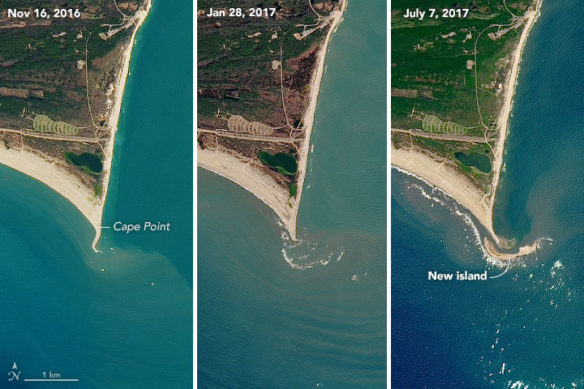
The waters off of North Carolina’s barrier islands have been called a “graveyard of the Atlantic.” Countless ships have wrecked here, due to the area’s treacherous weather and currents and its expansive shoals. These shoals are, by definition, usually submerged. But occasionally parts of them can rise above sea level.
These natural-color images, acquired by the Operational Land Imager (OLI) on the Landsat 8 satellite, show the shoal area off of Cape Point at Cape Hatteras National Seashore—the site of a newly exposed shoal nicknamed “Shelly Island.” The first image was captured in November 2016. When the second image was acquired in January 2017, waves were clearly breaking on the shallow region off the cape’s tip. The site of those breakers is where the island eventually formed, visible in the third image captured in July 2017. The new island measures about a mile long.
Captions and Image source: NASA / Earth Observatory
Excerpts;
Whatever mysterious forces crafted the new, crescent-shaped island at Cape Point is steadily gulping down the south end of Hatteras Island, spitting aside trees, power poles and a popular route for off-road vehicles…
Read Full Article, The Outer Banks Voice (11-01-2017)
Irma builds bridge between Hatteras Point and Shelly Island; The Outer Banks Voice (09-20-2017)
Rough surf from Hurricane Irma brought more than just great waves to the popular Shelly Island sandbar. It also brought some dramatic changes to the long formation off of Cape Point…
New Island Appears Off U.S. Coast; The National Geographic (06-27-2017)
It appeared out of nowhere in April just off North Carolina’s Outer Banks—a new land mass poking through the surf, a brand new Atlantic Ocean island. This new formation is of a scale rarely seen…
“The Beaches Are Moving,” A Video featuring Orrin Pilkey, PhD
World famous coastal geologist Orrin H. Pilkey takes us to the beach and explains why erosion has become a problem…
Sinking Atlantic Coastline Meets Rapidly Rising Seas; Climate Central (04-15-2016)
Geological changes along the East Coast are causing land to sink along the seaboard. That’s exacerbating the flood-inducing effects of sea level rise, which has been occurring faster in the western Atlantic Ocean than elsewhere in recent years…









